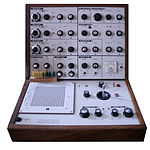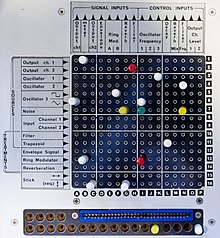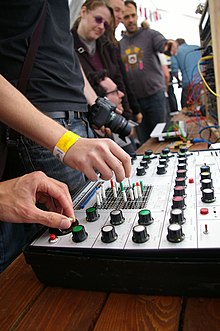
A digital synthesizer is a synthesizer that uses digital signal processing (DSP) techniques to make musical sounds. This in contrast to older analog synthesizers, which produce music using analog electronics, and samplers, which play back digital recordings of acoustic, electric, or electronic instruments. Some digital synthesizers emulate analog synthesizers; others include sampling capability in addition to digital synthesis.
A music sequencer is a device or application software that can record, edit, or play back music, by handling note and performance information in several forms, typically CV/Gate, MIDI, or Open Sound Control, and possibly audio and automation data for digital audio workstations (DAWs) and plug-ins.

Oxygène is the third studio album by French electronic musician and composer Jean-Michel Jarre. It was first released in France in December 1976 by Disques Motors, and distributed internationally in 1977 by Polydor Records. Jarre recorded the album in a makeshift studio that he set up in his apartment in Paris, using a variety of analog and digital synthesizers, and other electronic instruments and effects.

Modular synthesizers are synthesizers composed of separate modules for different functions. The modules can be connected together by the user to create a patch. The outputs from the modules may include audio signals, analog control voltages, or digital signals for logic or timing conditions. Typical modules are voltage-controlled oscillators, voltage-controlled filters, voltage-controlled amplifiers and envelope generators.

A groovebox is a self-contained electronic or digital musical instrument for the production of live, loop-based electronic music with a high degree of user control facilitating improvisation. The term "Groovebox" was originally used by Roland Corporation to refer to its MC-303, released in 1996. The term has since entered general use, and the concept dates back to the Movement Computer Systems Drum Computer in 1981.

A sampler is an electronic musical instrument that records and plays back samples. Samples may comprise elements such as rhythm, melody, speech, sound effects or longer portions of music.

The Roland MC-8 MicroComposer by the Roland Corporation was introduced in early 1977 at a list price of US$4,795. It was one of the earliest stand-alone microprocessor-driven CV/Gate music sequencers, following EMS Sequencer 256 in 1971 and New England Digital's ABLE computer (microprocessor) in 1975. Roland called the MC-8 a "computer music composer" and it was considered revolutionary at the time, introducing features such as a keypad to enter note information and 16 kilobytes of random access memory which allowed a maximum sequence length of 5200 notes, a huge step forward from the 8-16 step sequencers at the time. It also allowed the user to allocate multiple pitch CVs to a single Gate channel, creating polyphonic parts within the overall sequence. Due to the high price, only 200 units were sold worldwide, but it represented a huge leap forward in music technology.
Electronic Music Studios (EMS) is a synthesizer company formed in Putney, London in 1969 by Peter Zinovieff, Tristram Cary and David Cockerell. It is now based in Ladock, Cornwall.

The EMS Synthi 100 was a large analogue/digital hybrid synthesizer made by Electronic Music Studios, London, originally as a custom order from Radio Belgrade for what was to be the Radio Belgrade Electronic Studio, largely thanks to contact between composer Paul Pignon, then living in Belgrade, and Peter Zinovieff. The synthesiser was designed by David Cockerell and documented in detail in 1971. The cost at that time was £6,500. The last unit built by EMS was number 30. Afterwards, one final unit was built by Datanomics, who bought assets from EMS when the company folded in 1979. The redesigned unit was sold to Gabinete de Música Electroacústica, Cuenca, Spain.

The EMS Synthi A and the EMS Synthi AKS are portable modular analog synthesisers made by EMS of England. The Synthi A model debuted in May 1971, and then Synthi AKS model appeared in March 1972 a with a built-in keyboard and sequencer. The EMS Synthi models are notable for its patch pin matrix, its functions and internal design are similar to the VCS 3 synthesiser, also made by EMS. EMS is still run by Robin Wood in Cornwall, and in addition to continuing to build and sell new units, the company repairs and refurbishes EMS equipment.

Les Chants Magnétiques is the fifth studio album by French electronic musician and composer Jean-Michel Jarre, released on Disques Dreyfus on 20 May 1981. The album reached number six in the United Kingdom, number 98 in the United States and number 76 in Australia.

Sessions 2000 is the fourteenth studio album by French electronic musician and composer Jean-Michel Jarre, released on Disques Dreyfus and distributed by Sony Music in 2002. On January 7, 2003 was released in US. Sessions 2000 featured Francis Rimbert, and was recorded at Croissy studio and later mixed at Square Prod studio by Joachim Garraud. The album reached the 140th position in French charts.

The Moog synthesizer is a modular synthesizer invented by the American engineer Robert Moog in 1964. Moog's company, R. A. Moog Co., produced numerous models from 1965 to 1981, and again from 2014. It was the first commercial synthesizer and established the analog synthesizer concept.
White Noise are an English experimental electronic music band formed in London in 1968, after American-born David Vorhaus, a classical bass player with a background in physics and electronic engineering, attended a lecture by Delia Derbyshire, a sound scientist at the BBC Radiophonic Workshop. Derbyshire and Brian Hodgson, then both former members of electronic music project Unit Delta Plus, joined Vorhaus to form the band.
Synapse Audio Software is a software company located in Germany. Previously known as Sonic Syndicate and headed by Richard Hoffmann, they develop music production software for the Mac OS and Microsoft Windows platforms. They started developing software in November 1998 as Sonic Syndicate and changed their name to Synapse Audio with the release of Orion Platinum in 2002.
Peter Zinovieff was a British composer, musician and inventor. In the late 1960s, his company, Electronic Music Studios (EMS), made the VCS3, a synthesizer used by many early progressive rock bands such as Pink Floyd and White Noise, and Krautrock groups as well as more pop-orientated artists, including Todd Rundgren and David Bowie. In later life, he worked primarily as a composer of electronic music.
Zorch, who formed in 1973, were an early English totally electronic band, pioneering integrated performances of synthesizers and lightshow. Originally a four-piece, by 1975 Zorch were performing as a duo: Basil Brooks and Gwyo Zepix played three monophonic EMS analogue synthesizers, but were augmented by Silver (dance) and a full-on psychedelic light show, provided by John Andrews under the name of 'Acidica'. At times reminiscent of Tim Blake as well as Tonto's Expanding Head Band, their repetitive melodies, extended improvisation and thumping sequenced bass created a unique musical style that anticipated techno and trance. In the days before polyphonic synthesizers and personal computers, they filled out the sound using two reel-to-reel tape machines as a delay line.
"On the Run" is the third track from English rock band Pink Floyd's 1973 album, The Dark Side of the Moon. It is an instrumental piece performed on an EMS synthesizer. It deals with the pressures of travel, specifically air travel, which according to Richard Wright, would often bring fear of death.

Forever Alien is the third studio album by British space rock band Spectrum, a project led by Peter Kember under the pseudonym Sonic Boom. It was released in August 1997 by Space Age Records. After the band's preceding EP Songs for Owsley (1996) moved them away from guitar-oriented music and towards electronic music, Forever Alien furthered this approach considerably, as Kember aimed to create a predominately electronic album that sounded organic and analogue in style. The record is dominated by vintage analogue synthesizers, including the EMS VCS 3 and EMS Synthi AKS. Kember had become fascinated by the synths as he felt they presented him with more musical possibilities than guitars.
David Cockerell is an electronics engineer and designer. He started his career in the synthesizer world when Peter Zinovieff hired him to work for his EMS company in Putney in 1966, where he designed classic EMS synthesizers such as the Synthi VCS3, Synthi AKS and Synthi 100. In 1974 he worked for Electro-Harmonix in New York, where he first designed guitar pedals like the Small Stone phaser and Electric Mistress flanger. Still working for Electro-Harmonix, in 1980, Cockerell designed one of the first digital delay pedals with looping capabilities, the Instant Replay, followed by the 2 Second Digital Delay in 1981 and the 16 Second Digital Delay in 1982. This led him later to work at Akai, where he was involved in the design of samplers like the S612, S900, S1000, and the famous MPC60.




















